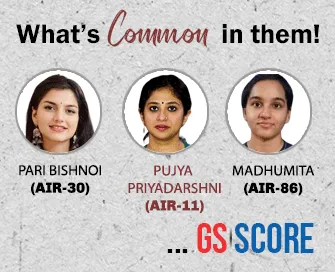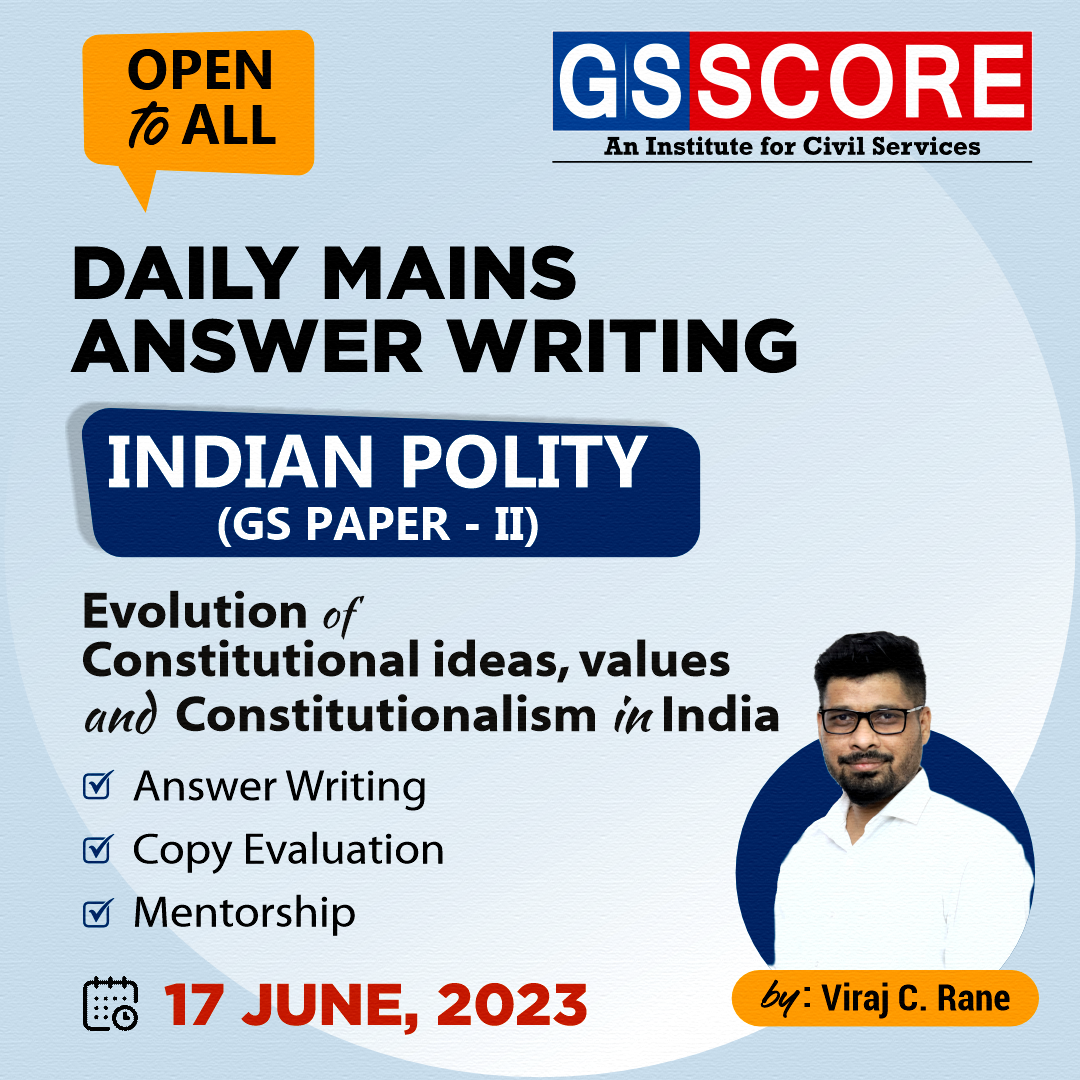

Indian Polity (Evolution of Constitutional ideas, values and Constitutionalism in India) by Viraj C. Rane

Instruction:
- There will be 2 questions carrying 10 marks each. Write your answers in 150 words
- Any page left blank in the answer-book must be crossed out clearly.
- Evaluated Copy will be re-uploaded on the same thread after 2 days of uploading the copy.
- Discussion of the question and one to one answer improvement session of evaluated copies will be conducted through Google Meet with concerned faculty. You will be informed via mail or SMS for the discussion.
Question #1. The harmonization between Fundamental Rights and Directive Principles of State (DPSPs) is a dynamic and evolving process. Discuss in the light of the judgments of the Supreme Court.
Question #2. The Constitutional amendments of India are aimed at adapting the Constitution to the evolving needs of the nation. Elaborate. Also, discuss the limitation imposed on amending the Constitution of India with suitable examples.
(Examiner will pay special attention to the candidate's grasp of his/her material, its relevance to the subject chosen, and to his/ her ability to think constructively and to present his/her ideas concisely, logically and effectively).
STEPS & INSTRUCTIONS for uploading the answers
Step 1 - The Question for the day is provided below these instructions. It will be available at 7:00 AM.
Step 2 - Uploading of Answers : Write the answer in A4 Sheet leaving proper margins for comments and feedback and upload the PDF in MY ACCOUNT section. Click on the option of SUBMIT COPY to upload the PDF.
Step 3 - Deadline for Uploading Answers: The students shall upload their answers by 7:00 PM in the evening same day. The first 50 copies will be evaluated.
Step 4 - Feedback : Mentors will give their feedback for the answers uploaded. For more personalised feedback, join our telegram channel by clicking on the link https://t.me/mains_answer_writing_cse . A one-to-one session will be conducted with the faculty after copy evaluation in 72 Hrs.
Model Answer
Question #1. The harmonization between Fundamental Rights and Directive Principles of State (DPSPs) is a dynamic and evolving process. Discuss in the light of the judgments of the Supreme Court.
Ans
Topic: Indian Constitution- historical underpinnings, evolution, features, amendments, significant provisions and basic structure
Sub-topic: Relation between Fundamental Rights and Directive Principles of State
Approach
- The question requires analysis of the relation between Fundamental Rights and Directive Principles of the State Policy
- Give a brief introduction about the importance of Fundamental Rights and Directive Principles of the State Policy
- Briefly discuss the evolved relationship between them. Cite some example from the verdicts of the Supreme court to substantiate your answer
- Conclude by discussing how they have complemented each other to balance social and individual interests.
Hints:
The harmony between Fundamental Rights and DPSPs is essential for maintaining a balance between individual interest and social interest, allowing for the inclusive development and welfare of society as a whole. Supreme Court in KC Ranjeevan case 1991 held that the fundamental rights and Directive principles of the State policy together constitute the core and conscience of the Constitution. The fundamental rights are justifiable political rights and DPSP are the socio economic goals which the state must strive to attain.
Harmony between these two provisions
- Interdependence of rights and duties: The Constitution emphasizes the interdependence of rights and duties. While Fundamental Rights guarantee certain liberties to individuals, the DPSPs highlight the responsibilities of citizens towards society. This interplay encourages individuals to exercise their rights in a manner that aligns with the larger social interest and welfare.
- Inclusive and equitable society: The Directive Principles of State (DPSPs) aim to establish a welfare state by promoting social justice, economic equality, and the overall well-being of the people. These principles guide the government in formulating policies and legislation to address Hints: Polity - 2 MTS-2966 | 5 GS SCORE GS SCORE GS SCORE socio-economic disparities and uplift marginalized sections of society. By ensuring a balance between individual rights and social interest, the DPSPs help create a more inclusive and equitable society.
- Reasonable Restrictions and framework for it justification: Fundamental Rights are subject to reasonable restrictions imposed by the state in the interest of public order, morality, and the sovereignty of the nation. The DPSPs provide a framework for the state to justify certain restrictions on individual rights, particularly when it comes to issues such as affirmative action, reservation policies, or socio-economic reforms aimed at bridging inequalities.
- Judicial Interpretation: The judiciary plays a crucial role in harmonizing Fundamental Rights and DPSPs. Courts often interpret and balance these provisions to ensure that the government's policies and actions are within the constitutional framework. The judiciary aims to reconcile conflicting interests and interpret the Constitution in a manner that upholds both individual rights and the larger social interest.
The judgment of the Supreme Court on harmonization between Fundamental Rights and Directive Principles of State (DPSPs)
- In the ChampakamDorairajan case (1951), the Supreme Court ruled that in case of any conflict between the Fundamental Rights and the Directive Principles, the former would prevail.
- In the Golaknath case (1967), the Supreme Court ruled that the Parliament cannot take away or abridge any of the Fundamental Rights, which are 'sacrosanct' in nature. In other words, the Court held that the Fundamental Rights cannot be amended for the implementation of the Directive Principles.
- The Parliament reacted to the Supreme Court's judgement in the Golaknath Case (1967) by enacting the 24th Amendment Act (1971) and the 25th Amendment Act (1971). The 24th Amendment Act declared that the Parliament has the power to abridge or take away any of the Fundamental Rights by enacting Constitutional Amendment Acts.
- The 25th Amendment Act inserted a new Article 31C which contained the following two provisions
– No law which seeks to implement the socialistic Directive Principles specified in Article 39 (b) 22 and (c)23 shall be void on the ground of contravention of the Fundamental Rights conferred by Article 14 (equality before law and equal protection of laws), Article 19 (protection of six rights in respect of speech, assembly, movement, etc) or Article 31 (right to property).
– No law containing a declaration for giving effect to such policy shall be questioned in any court on the ground that it does not give effect to such a policy.
- In the KesavanandaBharati case (1973), the Supreme Court declared the above second provision of Article 31C as unconstitutional and invalid on the ground that judicial review is a basic feature of the Constitution and hence, cannot be taken away. However, the above first provision of Article 31C was held to be constitutional and valid.
- In the 42nd Amendment Act, it accorded primacy to DPSP over the FRs under Articles 14, 19, and 31.
- In the Minerva mills case, the SC held that the constitution is founded on the bedrock of balance between the FR and DPSP. They both are necessary for bringing social harmony. Absolute primacy to one over other will disturb the harmony of the constitution.
- In the IR Coelho case, SC reiterated that FR and DPSP don't contradict but form a harmonious construct.
Conclusion:
In recent times, the horizon of FR has been broadened. Liberal interpretation of Articles is seen like article 21 to include rights like right to clean environment, right to live with dignity, etc. On the same lines, DPSP are being implemented. Eg., Right to livelihood under MNREGA, Right to Education, Right to Health. On the other hand, the social environment in the country is not conducive for implementation of some of the DPSP like Uniform Civil Code. Thus, the emerging relationship between Fundamental Rights and Directive Principles of State Policy has balanced the social interest and individual interest and has further strengthened the core of the Indian constitution.
Question #2. The Constitutional amendments of India are aimed at adapting the Constitution to the evolving needs of the nation. Elaborate. Also, discuss the limitation imposed on amending the Constitution of India with suitable examples.
Ans
Map Topic: MapIndian Constitution- historical underpinnings, evolution, features, amendments, significant provisions and basic structure
Sub-topic: Constitutional amendment
Approach
- The Question requires analysis of the Constitutional amendments of India in light of changing needs and aspirations of India
- Introduce by writing about the Constitutional amendments 8
- Then explain how constitutional Amendments are aimed at adapting the to the evolving needs of the nation
- Write about the limitation imposed on the amending power of the constitution of India 5. Then Conclude by writing about the significance of limitation on amending the Constitution
Hints:
Amending the Constitution of India is the process of making changes to the nation’s fundamental law or supreme law. The constitutional amendments play a crucial role in safeguarding the sanctity of the Constitution of India and maintaining a balance of power and aimed at meeting the evolving needs of the nation.
Constitutional Amendments are aimed at adapting the Constitution to the evolving needs of the nation
- The process of amending the Constitution in India is outlined in Article 368. It requires a special majority in both houses of Parliament (a two-thirds majority of members present and voting) as well as ratification by a majority of state legislatures, or in some cases, a simple majority in a national referendum.
- Over the years, India has undergone various social, political, and economic changes, and constitutional amendments have been a means to address these changes and ensure that the Constitution remains relevant and effective. Amendments allow for the modification, addition, or deletion of provisions in the Constitution, enabling the government and the legislative bodies to respond to emerging challenges and meet the aspirations of the people.
- Through constitutional amendments, India has brought about significant changes in various areas, including fundamental rights, electoral reforms, reservation policies, decentralization of power, and more. These amendments reflect the evolving needs of the nation and aim to strengthen democratic governance and promote social justice.
Recent example of Constitutional Amendments to meet the evolving needs of the nation
- The 101 Constitutional Amendments: This amendment introduced a national Goods and Services Tax (GST) in India from 1 July 2017.The Goods and Services Tax (GST) has several benefits that help in integrating the economy while making Indian products more competitive internationally.
- The 102nd Amendment: It inserted Article 338B into the Constitution. It granted constitutional status to the National Commission for Backward Classes (NCBC).It is an important constitutional body of India that investigates the conditions and difficulties of the socially and educationally backward classes.
- The 103 Constitutional Amendment Act: It brought in a 10% reservation for Economically Weaker Sections (EWS) of society other than Backward Classes, Scheduled Castes, and Scheduled Tribes for admission to central government and private educational institutions and recruitment in central government jobs.
Limitation imposed on the amending power of the constitution of India
- Amendment in the manner provided: The Constitution can be amended any number of times by the Parliament; but only in the manner provided. There is no such limit provided in the constitution of India which allows it to enact only certain number of amendments in a year.
- Amendment in parliament: Although Parliament must preserve the basic framework of the Constitution, there is no other limitation placed upon the amending power, meaning that there is no provision of the Constitution that cannot be amended. In Abdul RahimanJamaluddin v. VithalArjun (AIR 1958 Bombay, 94, (1957)), the Bombay High Court held that any attempt to amend the Constitution by a Legislature other than Parliament, and in a manner different from that provided for, will be void and inoperative.
- GolakNath and Ors. vs. State of Punjab: The Supreme Court first struck down a constitutional amendment in 1967, ruling in the case of I.C. GolakNath and Ors. vs. State of Punjab and Anr. An amendment was struck down on the basis that it violated Article 13: “The State shall not make any law which takes away or abridges the rights conferred by [the charter of Fundamental Rights]”. The term “law” in this article was interpreted as including a constitutional amendment
- KesavanandaBharati vs. The State of Kerala: The current limitation on amendments comes from KesavanandaBharati vs. The State of Kerala, where the Supreme Court ruled that amendments of the constitution must respect the “basic structure” of the constitution, and certain fundamental features of the constitution cannot be altered by amendment.
- Supreme Court in Minerva Mills v. Union of India: Parliament attempted to remove the above limitation by enacting the Forty-second Amendment, which declared, among other provisions, that “there shall be no limitation whatever on the constituent power of Parliament to amend ...this Constitution”. However, this change was itself later declared invalid by the Supreme Court in Minerva Mills v. Union of India.
- NJAC: In 2015, the Constitution Bench of Supreme Court by a majority upheld the collegium system and struck down the NJAC. The Supreme Court observed that the NJAC’s judicial component was not adequately represented by the Chief Justice of India and the next two senior Supreme Court judges, and their inclusion was insufficient to maintain the judiciary’s primacy in the process of choosing and appointing judges.
- 97th constitutional amendment: The Supreme Court in 2021upheld the validity of the 97th constitutional amendment (Part IX B) that deals with issues related to effective management of cooperative societies but struck down a part inserted by it which relates to the Constitution and working of cooperative societies. Thus, the limitations ensure that constitutional amendments are not easily made and helps maintain a balance of power between the Parliament and the judiciary, preventing arbitrary changes to the Constitution.


